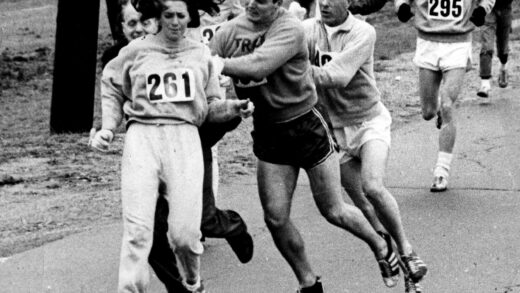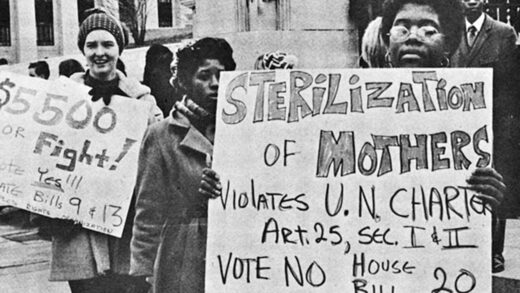by Sylvie Stempel-Jung

Seen through the lens of a moment when feminist groups were separating themselves from the medical establishment to seek other forms of body knowledge, these handbooks on herbal abortion can be understood as a kind of resistance to Western medical practices built on oppressive structures. These handbooks serve as practical guides to the self-administered herbal abortion, framing the choice at a crossroads between necessity and empowerment. In a post-Roe world, as we once again consider abortion outside the medical system, these handbooks (and context which we situate them in) offer historical strategies for healthcare.

![The dedication of a handbook, which explicitly thanks the "women healers [...] who have researched, practiced and passed down information on birthing, contraception and abortion from woman to woman, so that all women can have control over their reproductive lives."](https://sites.smith.edu/listening-for-rj/wp-content/uploads/sites/836/2024/11/Screenshot-2024-11-19-at-11.20.44-AM-697x1024.png)

Transcript, “Abortion Ourselves: Alternatives to the Medical System, Now and Then”
As we once again find ourselves in a moment where abortion is under attack, it’s worth looking back on the formation of the women’s health movement in the latter 20th century to glean strategies for a feminist intervention in healthcare. Today, I’m going to be walking you through a brief history of the women’s health movement, specifically honing in on the media from this time to demonstrate the strategies this movement adopted to ensure women had access to healthcare. This podcast attempts to shed light on healthcare strategies that operate outside the medical system, not because I’m advocating for a complete disavowal of medical care, but because I acknowledge the past and present failures of a system that often undermines gender minorities and uplifts a patriarchal, condescending approach to women’s healthcare. In a post-Dobbs world, where doctors face harsh consequences for providing abortions and women are dying simply because they’re reluctant to go to the hospital for fear that they’ll be prosecuted, alternatives to the medical system have proved themselves worthy of serious examination. It’s my hope that this examination of the women’s health movement and their approaches gives us some strategies for survival and continued access to healthcare.
The women’s healthcare movement came about as a result of groups of women across the country meeting to discuss their bodies and the dearth of accessible information about them. As historian Sandra Morgan chronicled, a huge focus of these health collectives was “demystifying health information, demedicalizing key aspects of women’s reproductive processes, and deprofessionalizing routine health services.” This looked like many different things: encouraging women to be familiar with their vulvas, hosting workshops on birth control pills and their side effects, teaching women to examine their breasts for cancer, and many other hands-on, self-guided approaches to body-knowledge. The goal wasn’t just personal empowerment, though – it was decentering organized medicine and its tradition of neglecting the bodies of marginalized groups. This looked different depending on who was at the helm.
In the case of the most well-known publication to emerge from the movement – the 1973 book Our Bodies, Ourselves, which was published by the Boston Women’s Health Book Collective – decentering organized medicine looked like reinstating women as legitimate sources of information about their own bodies in conjunction with physician-guided care. In contrast, two handbooks found in the Sophia Smith Archives – Herbal Abortion: The Fruit of the Tree of Knowledge and When Birth Control Fails: How to Abort Ourselves Safely – totally do away with Western medicine, instead offering women guides to self-managed abortions with abortifacients. Written by herbalists after abortion was legalized – 1994 and 1979 respectively – these handbooks are the product of an intentional pivot away from clinical care that neglected or rejected their knowledge. I say this because herbal abortions have sometimes been framed as desperate, misguided, and dangerous, and though this podcast is not an endorsement of abortifacients, I want to stress that herbal abortion in this context is a conscious choice. That said, because of the imprecise nature of herbal abortions, and the lack of scientific research on the broader health effects of abortifacients – as each book is careful to disclaim – these handbooks stress the importance of leaning heavily on networks of women. This could look like “working with the assistance of knowledgeable herbalists, healers, wise-women, and friends,” as one handbook writes, and/or trusting those who have self-aborted (like the authors of each handbook). When Birth Control Fails even has a survey on the back, which begins: “Feedback on self abortion methods would be greatly appreciated, so that we can share this information with other women.” Questions include: “If the abortion failed, why do you think it failed,” “Do you have any suggestions,” and “Did you have or need any assistance to do the abortion?” By encouraging women to send in feedback on their abortion experiences, there’s a clear lineage between herbal abortion handbooks and Our Bodies Ourselves in their community-based healthcare approaches and their elevation of women’s lived experience, despite the fact that these publications ultimately advocated for wildly different forms of healthcare.
So that was a brief history of the women’s healthcare movement and a few microcosms of its different strands. We’re living in a very different time now – what are we taking with us? What are we simply appreciating as historical snapshots?
Our post-Roe world obviously looks a lot different than the pre-Roe world. Abortion activists have harnessed the powers of the internet, and telehealth has made abortion pills “the frontline of the battle for abortion access,” as Smith professor Carrie Baker writes in her new book, Abortion Pills: US History and Politics. Abortion pills – commonly you take two, mifepristone and misoprostol – are approved by the FDA, and are termed a medical abortion. This is to say that abortion pills do not operate outside the medical system, like herbal abortions. If taken correctly, they also have a high success rate (between 92 and 99 percent), as opposed to the much spottier herbal abortion success rate (which is hard to quantify because of the multitude of ways one can induce a miscarriage).
Though it was never part of the mainstream, herbal abortion gained traction again immediately after Roe was overturned, with social media posts providing information on different abortifacients. But Google “herbal abortion,” and a spate of headlines crop up from 2022 decrying herbal abortion as unsafe. Interestingly enough, a lot of herbalists, like Susun Weed, one the first herbalists to publish on abortifacients, are also moving away from herbal abortion, citing its unpredictability and the better options available in the US – namely, the abortion pill. From this, I’m positing that because of safer abortion alternatives, this post-Roe movement is shifting away from tactics like herbal abortion and staying within the medical system to self-abort.
Despite the fact that herbal abortion seems to have lost its relevance as an abortion method, I still think the philosophies behind the handbooks remain important. Core tenets of the women’s health movement – giving women agency over their healthcare, letting body knowledge guide health decisions, working in conjunction with communities of people who need care, and acknowledging the use of alternative medicines in reproductive justice work – can guide the way forward. We owe a tremendous amount to this movement and those who came before – and we still have so far to go.
References
Bader, Eleanor. “In New Book on Abortion Pills, Carrie Baker Chronicles the History of Resistance and Resilience That Changed the Abortion Landscape.” Ms. Magazine, 11/27/24. https://msmagazine.com/2024/11/27/new-book-abortion-pills-carrie-baker-history-mifepristone-usa/
Gage, Suzann. When Birth Control Fails: How to Abort Ourselves Safely. Speculum Press, 1979.
Lewis, Maya. “Drink Me and Abort Your Baby: The Herbal Abortion Tea.” CUNY Academic Works, 12/16/16. https://academicworks.cuny.edu/cgi/viewcontent.cgi?article=1146&context=gj_etds
“Medication Abortions: Your Questions Answered.” Yale Medicine, 9/1/23. https://www.yalemedicine.org/news/medication-abortion-your-questions-answered
Morgan. Sandra. Into Our Own Hands: The Women’s Health Movement in the United States, 1969-1990. Rutgers University Press, 2002.
Newsletter of the Federation of Feminist Women’s Health Centers, Vol. 1, No. 1, 1980. Women’s Heath Specialists of California Records, Sophia Smith Collection of Women’s History, SSC-MS-00790. Box 1.
Rosinger-Zifko, Theresa, Upadhyay, Ushma, and Salles, Arghavan. “The Ripple Effects of Restricting Abortion Access.” Ms. Magazine, 11/1/24. https://msmagazine.com/2024/10/31/abortion-bans-infant-mortality-maternal-health-death-mother-texas-georgia/
Soetirto, Rania and Kaufman, Sarah. “Women who’ve tried ‘herbal abortions’ urge others not to follow their lead.” NBC News, 7/22/22. https://www.nbcnews.com/health/health-news/women-ve-tried-herbal-abortions-urge-others-not-follow-lead-rcna39563
“The Women’s Health Movement.” Clio History, Accessed 11/16/24. https://www.cliohistory.org/click/body-health/health
Tiamat, Uni M. Herbal Abortion: The Fruit of the Tree of Knowledge. 1994.


